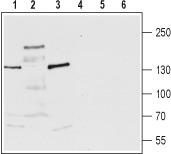TRPM3 Rabbit Polyclonal Antibody
Other products for "TRPM3"
Specifications
| Product Data | |
| Applications | WB |
| Recommended Dilution | WB: 1:200-1:2000 |
| Reactivities | Human, Mouse, Rat |
| Host | Rabbit |
| Clonality | Polyclonal |
| Immunogen | Peptide KNKDDMPYMSQAQEIHC(C), corresponding to amino acid residues 816-831 of human TRPM3. 1st extracellular loop. |
| Formulation | Lyophilized. Concentration before lyophilization ~0.8mg/ml (lot dependent, please refer to CoA along with shipment for actual concentration). Buffer before lyophilization: Phosphate buffered saline (PBS), pH 7.4, 1% BSA, 0.05% NaN3. |
| Purification | Affinity purified on immobilized antigen. |
| Conjugation | Unconjugated |
| Storage | Store at -20°C as received. |
| Stability | Stable for 12 months from date of receipt. |
| Gene Name | transient receptor potential cation channel subfamily M member 3 |
| Database Link | |
| Background | Transient receptor potential (TRP) channels are relatively non-selective ion channels enabling the exchange of cations down their electrochemical gradient. This exchange enables the intracellular rise in Na+ and Ca2+ concentration and ultimately in the cell membrane depolarization, important for action potential propagation and muscle contraction. They are activated by an extremely broad range of stimuli namely, temperature, voltage, pH, endocrine factors as well as signaling molecules. The TRP channel family is composed of 28 members divided in 7 subgroups: TRPV, TRPC, TRPM, TRPA, TRPN, TRPP and TRPML. All members of the TRP family have 6 transmembrane (TM) domains, and a pore domain between the fifth (S5) and sixth (S6) transmembrane domains. In general, TRP channels enable the passage of either Na+ or Ca2+ ions with little or no preference. However, some channels do exhibit some selectivity. Also, TRP channels do not display the positive charges in the S4 voltage-sensing domain like most voltage sensitive channels, although they do display voltage dependency. In addition, TRP channels have in the C-terminal intracellular region to the S6 domain a TRP domain comprising 25 amino acids that is more or less conserved among most TRP channels. Within the TRP domain, there is a TRP box composed of six amino acids, and TRP box 2 â?? a proline rich domain. The TRP domain seems to be responsible for the binding of PIP2, a phospholipid important for the regulation of channel activity. The TRPM subfamily consists of 8 members divided in to three major groups: TRPM1/3, TRPM4/5, and TRPM6/7. TRPM2 and TRPM8 are not included in any of the groups since they are quite different even with respect to each other. TRPM3 is alternatively spliced into active variants. TRPM3a1 and TRPM3a2 in mouse are monovalent and divalent-selective channels, respectively. This differential selectivity strongly suggests that their cellular role depends on the relative expression of each variant type. In addition, both splice variants display constitutive outwardly rectifying currents. They somewhat resemble TRPM6 and TRPM7 channels such that their currents are inhibited by intracellular Mg2+ . TRPM3 is highly expressed in the kidney, and to a lesser extent in the brain, testis, and spinal cord. |
| Synonyms | GON-2; LTRPC3; MLSN2 |
| Reference Data | |
| Protein Families | Druggable Genome, Ion Channels: Transient receptor potential, Transmembrane |
Documents
| Product Manuals |
| FAQs |
{0} Product Review(s)
0 Product Review(s)
Submit review
Be the first one to submit a review
Product Citations
*Delivery time may vary from web posted schedule. Occasional delays may occur due to unforeseen
complexities in the preparation of your product. International customers may expect an additional 1-2 weeks
in shipping.






























































































































































































































































 Germany
Germany
 Japan
Japan
 United Kingdom
United Kingdom
 China
China



